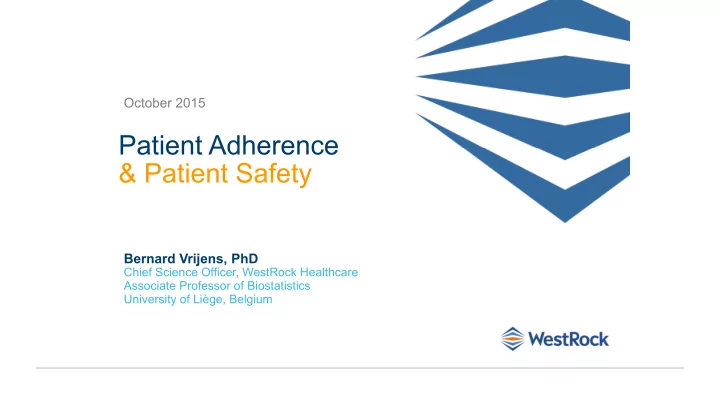

October 2015 Patient Adherence & Patient Safety Bernard Vrijens, PhD Chief Science Officer, WestRock Healthcare Associate Professor of Biostatistics University of Liège, Belgium
Adherence is Key to Therapeutic Success Effective Adherence to Effective Therapies Medications Disease Management “Drugs don’t work in patients who do not take them.” – C. Everett Koop, former US Surgeon General “Drugs may create harm in patients who do not take them appropriately.” 2
Medication adherence: Definition The process by which patients take their medications as prescribed ! ! Initiate " Implement # Persist time Patient does Patient delays, Patient not initiate omits or takes discontinues treament extra doses treatment Binary (yes/no) Dosing history Time to event EU Commission-sponsored research Vrijens et al. Br J Clin Pharmacol 2012;73:691-705. ! 3 !
Adherence Measurement Methods Reliable Method Therapeutic " Automatic drug monitoring ! compilation of dosing history data ! Pharmacy refill data ! Sparse Sampling Rich Sampling Retrospective " Patient diary ! questionnaire ! Pill Counts ! Biased Method Modified from Vrijens & Urquhart, 2005 Journal of Antimicrobial Chemotherapy.
Electronically Compiled Dosing History Data Each of the 4 patients took 75% of prescribed doses during a 3-month period ! Vrijens et al., Expert Review Clinical Pharmacology, 2014 5 5
Consequences of medication non-adherence & Specific safety considerations ! Initiate " Implement # Persist time Drugs stop Drugs work Drugs don’t work working in partially or may in patients who do patients who create harm in not initiate them discontinue patients who them implement a dosing regimen sporadically Recurrent first- Potential dose effects Rebound Drugs’ (Titration) Effects Forgiveness 6 !
The concept of drugs’ forgiveness or how much implementation is enough? Increased risk of toxicity Concentration 24h Periodic loss of effectiveness 0 1 2 3 4 5 6 7 8 9 10 11 12 13 14 15 Dosing time (Day) 7
Variable adherence creates drug-specific issues of efficacy and safety Occasional toxicity Periodic loss of effectiveness & emergence of drug resistance Blaschke, Osterberg, Vrijens, Urquhart, 2012, Ann Rev Pharmacol Toxicol, 52:275-301 8
Addressing adherence is key to avoid treatment escalation, the driver for costs Poor adherence Initiation-Implementation-Persistence More complex Treatment failure treatments Disease progression 9 !
The Adherence Gap Method effectiveness (efficacy) Potential consequences Suboptimal Outcomes of this gap: adherence • Risk of failure related Patient selection to lack of effectiveness Use Patient follow-up • Poor estimation of toxicity effectiveness • Inappropriate dosing regimen • Lost revenue/share Phase III Phase I Phase II Market Drug development Adherence becoming a regulatory priority Draft guidance from the US FDA explicitly addresses adherence strategies http://www.fda.gov/Drugs/GuidanceComplianceRegulatoryInformation/Guidances/default.htm. Dec 2012 Blaschke, Osterberg, Vrijens, Urquhart. Annual Review, 2012. 10
Extent of non-adherence in clinical trials Perfect adherence Perfect adherence Perfect adherence 100 Decrease in adherence due to discontinuation 90 of treatment (nonpersistence) 80 % of patients engaged D e c r e a s with the dosing regimen e ¡ i n ¡ a d d h u e e r ¡ e % of patients t o n ¡ c p e o ¡ ¡ o r ¡ i m p l e 70 m e n t a 2 o n ¡ Persistence 60 Adherence % of patients who 50 dosed correctly 16,907 participants from 95 clinical studies Interactive 0 100 200 300 Time (days) Blaschke, Osterberg, Vrijens, Urquhart, Annual Review, 2012. 11
Adherence-uninformed clinical development Efficacy Safety Best dosing regimen? ! Drug development Market Phase I Phase II Phase III Compensate for diluted efficacy Unexpected Formulation ADR’s! Adherence? Highest Safe Dose* PK/PD « Variability makes prediction unreliable » *based on small, controlled, (adaptive) designs Peck et al., JAMA, 1993. ! 12 !
The Struthian Approach is No Longer An Option! Efficacy / Safety Optimal dose Forgiveness Concentration of Drugs 13
Overview of assessment methods of adherence in ambulatory patients ! Initiate " Implement # Persist time Requires sampling Sampling is too Subject to white coat Direct methods after prescription sparse adherence (PK/PD) ! Desirability bias Recall bias Desirability bias Self-report ! Easily censored by Only aggregate Easily censored by Pill counts ! patient summary patient Gold standard if both Only aggregate Gold standard but Prescription & databases combined summary retrospective refill databases ! Gold standard in CT; Gold standard in CT; needs patient Gold standard Electronic monitoring ! needs activation engagement Vrijens & Heidbuchel, Europace 2015. !
Conclusions • In drug development , adherence- informed clinical trials, based on reliably precise measurement of adherence, will yield more informative data on both safety and the dose-dependence of efficacy, resulting in better patient satisfaction and longer persistence with treatment • Depending on the drugs’ pharmacological properties, variable adherence leads to under- or over-dosing that can result in lack of effectiveness and/or safety issues: narrow therapeutic window, recurrent first-dose effects, and rebound effects. • In medical practice , when precise implementation of a dosing regimen is required, it becomes critical to provide patients not only the drug but also a monitoring system that supports the management of adherence to medications
Thank You for Your Attention Questions? 19 th ESPACOMP meeting will be held In Prague , Czech Republic , on the 13th and 14th November 2015 www.ESPACOMP.eu
Recommend
More recommend